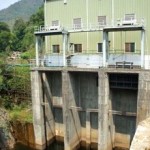The main purpose of placing another tank in between the mixing tank and main bio-digester is to maintain an input reservoir in order to account for a few days of unavailability in feedstock. In certain cases of large scale power application of this technology, waste heat is utilized from the gas engine exhaust and fed to the storage tank to double it up as a pre-digester by facilitating the growth of thermophilic bacteria and elimination of any pathogens.

The feed is then directed into the anaerobic digester. The most commonly used biogas plants for power generation using biogas are the Continuous Stirred Tank Reactors (CSTR). These reactors involve anaerobic digestion at mesophillic temperaturres and generally have a retention time of about 20-25 days. For smaller scales and other domestic and thermal applications of biogas, other reactors are also commercially available like the Floating Drum KVIC Model, Fixed Dome-type Model by TERI, the Janata Model or the TERI Enhanced Acidification and Methanation (TEAM) set-up which is essentially Upflow Anaerobic Sludge Blanket Reactor (UASB).
The quality and quantum of biogas depends on a variety of factors like the technology used, type of waste, moisture content, volatile matter, ash content, C/N ratio, etc. An important consideration while generating power using biogas is the desulphurization of the gas. Anaerobic process results in the formation of H2S which on combustion generates SO2. It is not only corrosive to the gas engine but also harmful to the environment.
To tackle this situation, chemical or biological desulphurization is carried out. The chemical desulphurization involves the use of FeCl2 in which chloride is replaced by sulphur owing to the higher affinity of the latter with iron. Biological desulphurization, on the other hand, utilizes the sulphur oxidizing bacteria and converts hydrogen sulphide into elemental sulphur in the presence of air.
An important component of a typical biogas facility is the gas holder, which is used to maintain a buffer between the production and consumption rates of the biogas. The gas is drawn into the gas engine from the gas holder and the waste heat generated is utilized to improve the overall efficiency of the system by directing it through the pre digester and the main digester.
Since the water effluent from such a process is expected to possess high BOD and COD characters, the need of a dedicated effluent treatment plant is ineluctable. This waste water is mainly obtained after the dewatering of the slurry obtained from the above process. The solid content in the slurry increases after going through the de-watering stage in multiple stage screw-presses and it can be sold as high quality compost in the market.
Present Scenario
Although the Municipal Solid Waste Management Directive (2000) mandates source segregation of waste which is easily biodegradable in nature, in reality it has not been able to find wide-spread implementation till now. The major reasons include lack of proper implementation and reporting mechanism, and lower degree of awareness among the people in general. In addition, urban waste in India is also mixed with a huge amount of rubble, construction and demolition waste and other such wastes, which render the food-waste unsuitable for subsequent conversion to energy.
Most of the organic waste generated in the country is either being dumped into the landfills or composted or sent to piggeries. It is a sheer waste of such biodegradable waste, capable of generating energy, to be sent into the landfills. There, it is not only responsible for large scale green house gas emissions, but also becomes a health hazard and creates terrestrial pollution.
There are numerous places which are the sources of large amounts of food waste and, hence, a proper food waste management strategy needs to be devised for them to make sure that either the waste is disposed off in a safe manner or utilized efficiently. These places include hotels, restaurants, malls, residential societies, college/school/office canteens, religious mass-cooking places, airline caterers, food & meat processing industries and vegetable markets, which generate organic waste of considerable quantum on a daily basis.
Conclusion
The anaerobic digestion technology is highly apt in dealing with the chronic problem of organic waste management in urban societies. Although the technology is commercially viable in the longer run, the high initial capital cost is a major hurdle towards its proliferation. The onus is on the government to create awareness and promote such technologies in a sustainable manner. At the same time, entrepreneurs, non-governmental organizations and environmental agencies should also take inspiration from successful food waste-to-energy projects in other countries and try to set up such facilities in Indian cities and towns.












